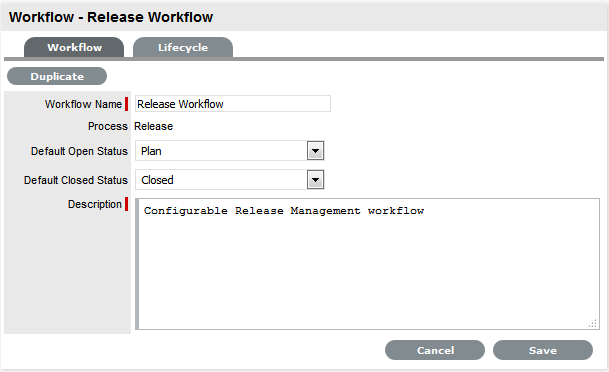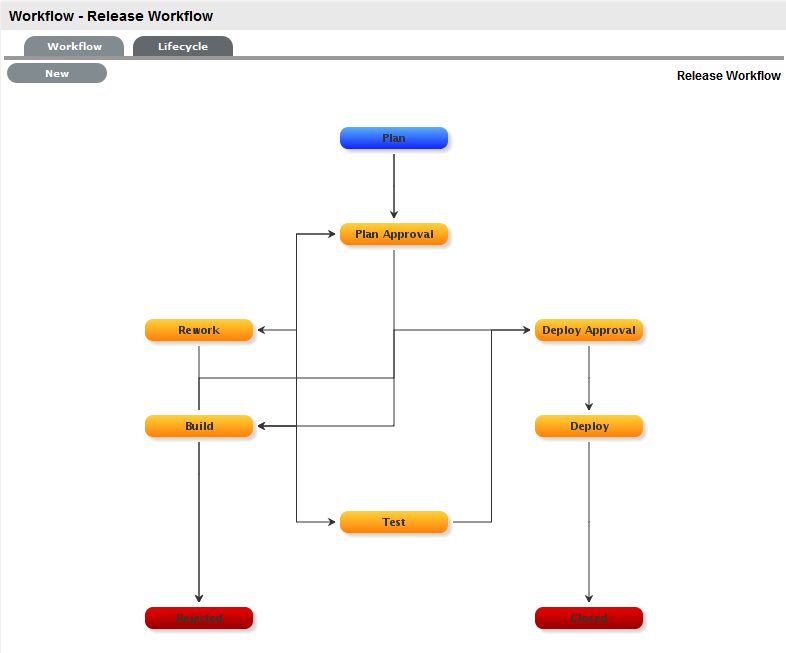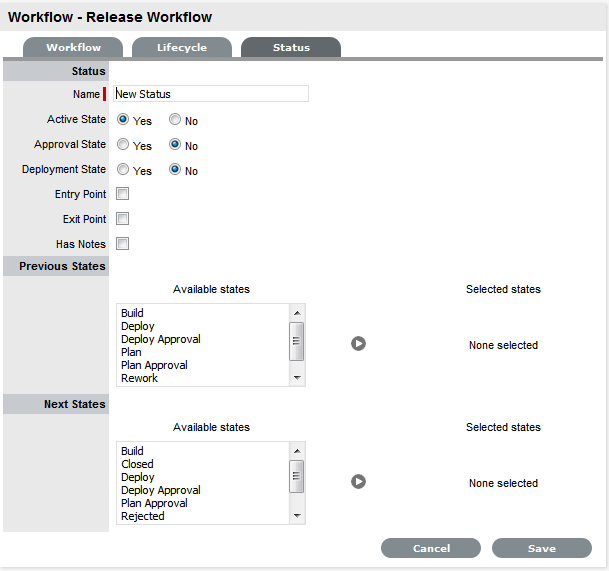1.55 Release Workflow
Release Workflows define the sequence of States to be followed for Releases logged within the Change>Release tab. By default the system includes one Release Workflow that can be adjusted to suit the service organization's requirements. There is no limit to the number of fully configurable Release Workflows that can be created in the system, so the diverse range of business release implementations required by an organization can be covered by the service and support organization.
1.55.1 Approval States
Approval States in Release Workflows provide the facility for Release Managers that have been assigned to the Approval State, to accept or reject Release activity. If Release Managers are to be assigned to an Approval State, then it is not possible for other User Roles to also be assigned to that State. It should be noted that a Technician, Supervisor or Partner user can also be assigned a Manager Role, which will allow them to be assigned to Manager Only Approval States.
For more information about Manager assignment to Approval States, see:Release Teams.
1.55.2 Editing the Default Workflow
To edit or duplicate the default Release Workflow:
-
Select Service>Workflows
-
Click the Release Workflow hyperlink to modify the template details or copy the Workflow

-
Click Edit, to amend or duplicate the Workflow
Fields in the following table are now editable
-
Field Name
Description
Workflow Name
Enter a relevant name for the Workflow.
Process
Release Management is assigned as the Workflow Process.
Default Open Status
The open State that a Release automatically applies when it is assigned the Workflow.
Default Closed Status
The Exit State that indicates the Release has reached the end of the Workflow Lifecycle.
Description
Defines the purpose of the Workflow.
-
Click Duplicate, if the default Workflow is to be copied
-
Amend the Release Workflow details as required
-
Click Save
-
Select the Lifecycle tab to create or modify Workflow States

1.55.3 Adding or editing Workflow States:
-
Click the State field in the Workflow map or State name hyperlink to display the Status information screen
Or, click New to create a new Workflow State.

Status
Name
System Default States can be re-named if desired. For newly created States, enter a name.
Active State
Assign Yes for requests to be available in the Home tab by default, when assigned to this stage of the Workflow.
Yes should be used for States where the User is actively working on the request or waiting for updates." No" generally applies to Workflow exit points and will only be available by default within the Release tab list view.
Approval State
Sets the Status as an Approval State. This allows a Release Manager to be assigned to this State and enables them to approve or reject Release Activity when it moves into this stage of the Workflow.
NOTE:An Entry/Exit status cannot be an Approval State.
Deployment State
If enabled for a State, when a Release is assigned this State the Deployment Tasks associated with the Release can be actioned by the Technician Users.
Entry Point
An Entry Point is used to indicate the start of a Lifecycle. To make the State a Workflow Entry Point, select the Entry Point checkbox.
As the Entry Point is the first State, the Previous States field will be removed.
Exit Point
Select if the State will be an Exit Point. An Entry Point is used to indicate the end of a Lifecycle.
NOTE:A Workflow can have only one Entry Point but multiple Exit Points.
Has Notes
Allows the Supervisor to include instructions or add relevant details to the Workflow that is made available when the Release moves into the State. The information is configured within the Notes tab that is displayed when this option is enabled.
Information and attachments included on the Notes tab, are displayed as a scroll-over when the Release moves into the State.
Listener Class
This field is visible if the Outbound Webservices option is enabled in the Admin>Setup>Privileges>System tab.
Complete this field, if assigning this State to a request is to trigger an event in an external system.
This field should contain the name of a Java class that implements the interface com.livetime.ws.listenWorkflowListener that has been compiled into a jar file and added to the LiveTime classpath. Please contact support for further details.
Previous States
If the State is not an Entry Point, Previous States can be assigned to the Workflow stage. Highlight the relevant State and use the arrow button to move Available States to the Previous States field. These options designate the Workflow stages a Release can come from, before it arrives in this Workflow State.
Next States
If the State is not an Exit Point, Next States can be assigned to the Workflow state. Use the arrow button to select the Next States from the Available States. These options are included in the Next Action drop-down menu of a Request.
Accept State
(Visible when the Approval State option is Yes.)
Displays the States that a Request can move to when a Release action is Accepted. Select the appropriate State, for the system to automatically route the Release when the Accept option is selected.
Approval
(Visible when the Approval State or KBA Approval option is Yes.)
Displays the States that a Request can move to when a Request action is Accepted. Select the appropriate State, for the system to automatically route the Request when the Accept option is selected.
-
Team Manager, select if a single Manager User assigned to the Team is to process the Request.
-
Team Managers# if selected, set the number of Managers that are required to Approve the Request before the system will automatically apply the defined Accept or Reject State.
-
Team Managers% if selected, set the percentage weighting that must be achieved by Managers voting before the system will automatically apply the defined Accept or Reject State. When selected, define the percentage weighting.
Reject State
(Visible when the Approval State option is Yes.)
Displays the States that a Release can move to when a Release activity is Rejected. Select the appropriate State, for the system to automatically route the Release when the Reject option is selected.
-
-
Configure the State details, as required
-
Save the updated State details
NOTE:It is recommended that all States that are to be included in the Workflow be added or re-named now
After all States have been entered in the system, the mapping of the Workflow can be more easily achieved.
-
Continue to edit, add or delete States until all relevant States exist for the Workflow
-
To create the Workflow Lifecycle, States need to be assigned to the transitional states of Previous and/or Next
To move Available States to the Previous State or Next State field, open the Status Details screen by clicking the State object in the Workflow map or select the State hyperlink in the table beneath the Workflow map.
-
Assign States to be Next and/or Previous States
For the Current Status highlight an option in the Available State list and click the right-pointing arrow to move it to the Selected States field.
NOTE:When a State is used as a Previous and a Next State, it allows a request to move forward and backward in a Lifecycle
An Open State cannot have any previous States and a Closed State cannot have any Next States.
-
Click Save to return to the Workflow map and to access other States to build on the Workflow lifecycle.
-
Repeat Steps 12 to 14 until all transitional stages of the Workflow have been mapped.
NOTE:To successfully save a Workflow, the sum Resolution Time of the individual Contract Types assigned to each transitional state of the Workflow Lifecycle, must be less than or equal to the Workflow's SLA Resolution Time
-
Click Save.
The visual representation of the Workflow is displayed.
1.55.4 Workflow Map
The Workflow Map is a visual representation of the Workflow Lifecycle. The map displays the relationship between each Lifecycle State by using different colors to represent the type of Lifecycle State.
|
Color |
|
|---|---|
|
Blue |
Indicates the Entry point of the Lifecycle. |
|
Orange |
Is a Transitional stage of the Lifecycle. |
|
Red |
Indicates the Exit point of the Lifecycle. |
Detailed information about a Lifecycle State can be accessed by clicking on the State field within the Map.
1.55.5 Deleting the default Release Workflow
To delete the default Release Workflow:
-
Select Service>Workflow
The Workflows screen appears.
-
Select the checkbox to the left of the Release Workflow
-
Click Delete
The checked Workflow is no longer visible.
NOTE:A Workflow that belongs to a Team cannot be deleted.
1.55.6 Deleting a Workflow State
It may be necessary to delete a system default State or a State that is no longer in use. Note that a State cannot be deleted if it has been assigned to a Release.
NOTE:It is recommended that any States listed in the table of States included on the Life Cycle tab that are not included in the Workflow or used by the system, be removed from the table as all States included here are listed in the States tab when Workflow Manager assignment is being configured. By removing unused States from the table, assigning Technicians to the relevant stages of the Workflow becomes an easier task.
To delete an unused State:
-
Select Service>Workflows
-
Click on the Workflow hyperlink
-
Move to the Lifecycle tab
-
Select the State name link in the table of States included in the Lifecycle tab
-
Click Delete
-
Click Done.